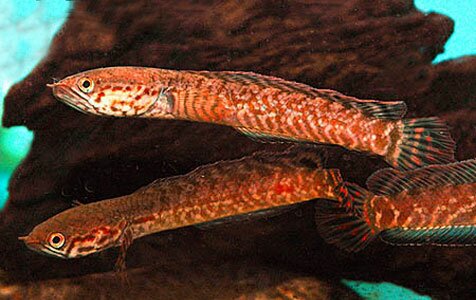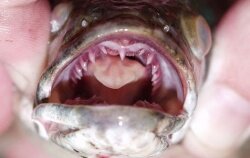Snakeheads: Invasive Aquatic Aliens
From Microcosm Aquarium Explorer
- Large Giant Snakehead caught in Maryland. Maryland Dept. of Natural Resources Photo
- Northern Snakehead sightings map, October 2008. U.S. Geological Survey (USGS)

- Rainbow Snakeheads, Channa bleheri, for sale in a pet shop. JJPhoto.dk
Aquarists and ethnic fishmongers blamed for spread of invasive species
One aquatic horror film proclaimed it "Part fish. Part snake. Pure Evil." National Geographic dubbed it "Fishzilla." Fishermen call it "A Pike on Steroids." The US Fish and Wildlife Service acknowledged the name "Frankenfish" and noted that Giant Snakeheads (Channa micropeltes) had "reportedly attacked, and in some instances killed, humans who approached the mass of young" being guarded by their parents.
The discovery of a breeding population of Northern Snakeheads (Channa argus) in Crofton, Maryland in 2002 spawned three bio-horror films: Snakehead Terror (2004), Frankenfish (2005), and the Swarm of the Snakeheads (2006).
Although all greatly stretched the biological truth about these toothy predators, aquarists who have kept a snakehead have no shortage of anecdotes about their ability to eat every last tankmate in an aquarium, even killing other fishes with slashing attacks and not bothering to eat the victims.
Ambush Predators
The Channidae are a family of 29 species of bottom dwelling ambush predators native to Asia that prey on other fish, crustaceans, frogs, snakes, and even turtles, rodents, and water fowl. They are highly regarded as a food fish in Asia, and respected by fishermen for biting human hands when caught. Harmless looking juveniles, although now banned, are sometimes available to aquarium keepers.
Sadly, some dismayed hobbyists are accused of turning troublesome adult snakeheads loose into local ponds, streams, rivers, and lakes. A spreading pattern of invasive snakehead populations has fish and wildlife authorities in many states on high alert for the appearance of these adaptable, voracious fishes. Biologists fear that their introduction to waters outside their native ranges may lead to declining populations of aquatic life not accustomed to the pressures brought by a large, gluttonous predator.
Slithering Invaders
Because they are well able to move overland from one body of water to another (living up to several days breathing air with a primitive labyrinth organ), snakeheads pose special challenges in keeping them contained. Escaped snakeheads tend to be hard to kill, although a number of infestations have been eradicated in several states.
The U.S. Geological Survey reports that Northern Snakeheads continue to spread in American waters, with 2008 sightings in Little Piney Creek near Monroe, Arkansas, in a pond on a Mount Vernon golf course in Fairfax, Virginia, and in Catlin Creek in Wawayanda, New York. One Northern Snakehead was caught in the in Potomac River in front of the Pentagon Building in 2007.
Amy J. Benson of the USGS in Gainesville, Florida says Northern Snakeheads have established themselves in Arkansas, New York, and Pennsylvania. "The snakeheads are not established everywhere they have been found," she says. "Unfortunately the small established populations are starting to spread a bit. The largest population by far is in the Potomac River in Virginia and Maryland."
In all, four different species of snakehead have been caught in the wild in the United States, in California, Florida, Hawaii, Maine, Maryland, Massachusetts, Rhode Island, and Wisconsin. Hawaii has an entrenched population of Chevron Snakeheads on Oahu, introduced as a food fish in the late 1800s. The Bullseye or Cobra Snakehead (Channa marulius), growing to a maximum of 180 cm in length and weighing up to 30 kg, is established as an invasive species in lakes and canals in Broward Country, Florida.
According to the USGS's Amy Benson, "Several Giant Snakeheads (Channa micropeltes) have been collected in Maryland since 2000, in addition to the Northern Snakeheads."
Sources of Released Fish
Aquarists "liberating" a snakehead that has grown too big and too predatory, or that has bitten the hand of its keeper, are blamed for some releases into the wild. However, this is a genus with a keen following in Asian food markets in the U.S., where it has been sold live by the tens of thousands, especially by Oriental fishmongers in larger urban centers such as Boston, New York, and Los Angeles.
Indeed, the suspected guilty party in the first release of snakeheads in Maryland was a man who had bought a number of live fish from a seafood market intending to use them for medicinal purposes for his ill sister. When her health improved, he dumped them in local pond.
According to the US Fish and Wildlife Service, snakeheads could conceivably gain a toehold in many parts of North America. "Based on water temperature alone, all US fresh or brackish waters would allow some member of the snakehead family to establish itself," says an online report called, "Frankenfish: The Facts."
"Because snakeheads are so predatory, they pose a high risk to endangered species. Of all endangered species in US aquatic habitats, 16 amphibians, 115 fishes, and five of the 21 federally protected crustaceans would most likely be affected by snakehead introductions."

The U.S. is not alone in worrying about the spread of snakeheads. In February 2008, an angler in Lincolnshire, England, caught a 24-inch (60 cm) Giant Snakehead (Channa micropeltes) in the River Witham. The fisherman, Andy Alder, told the British press: "It had a gob full of razor-sharp teeth. To be honest it looked terrifying." Authorities believe it was a single fish released into the river by an aquarium keeper and not part of a breeding population. The British have a fine of 2,500 pounds for releasing aquarium fish and have restricted the import of the Northern Snakehead (Channa argus).
Although their sale and possession without a permit are banned in the US, snakeheads are still obtainable via the Internet and occasionally turn up in the live fish trade. Aquarium keepers with snakeheads are strongly urged to ensure they do not end up in local waters, either by intentional release or escape. The US Fish and Wildlife Service can be called to remove a large snakehead that cannot be safely handled by its owner.
References & Further Information
- "Snakeheads," a downloadable USGS book. Highly recommended.
- Current USGS Snakehead Sightings Map
- "Snakeheads Go Beyond the Pond," Sea Grant Maryland
- Great Snakehead, Channa marulius.
- Channidae
- Fish Euthanasia








